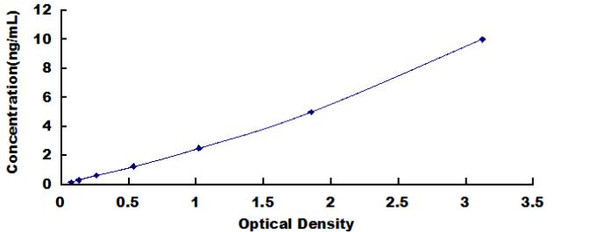Description
Rat ADORA1/Adenosine receptor A1 ELISA Kit
The Rat Adora1 (Adenosine Receptor A1) ELISA Kit is a valuable tool for the precise measurement of Adenosine Receptor A1 levels in rat serum, plasma, and cell culture supernatants. With its superior sensitivity and specificity, this kit delivers reliable and repeatable results, making it perfect for various research applications.Adenosine Receptor A1 is a critical component in the adenosine signaling pathway, regulating various cellular functions such as neurotransmission, inflammation, and cardiovascular activity.
Dysregulation of this receptor has been implicated in a range of disorders including neurodegenerative diseases, cardiovascular conditions, and immune-related disorders, making it a key target for research and drug development.Overall, the Rat Adora1 (Adenosine Receptor A1) ELISA Kit offers researchers a powerful tool for investigating the role of Adenosine Receptor A1 in various physiological and pathological processes, paving the way for potential therapeutic interventions in the future.
| Product Name: | Rat ADORA1/Adenosine receptor A1 ELISA Kit |
| Product Code: | RTFI00552 |
| Size: | 96 Assays |
| Target: | Rat ADORA1 |
| Alias: | ADORA1 |
| Reactivity: | Rat |
| Detection Method: | Sandwich ELISA, Double Antibody |
| Sensitivity: | 0.188ng/ml |
| Range: | 0.313-20ng/ml |
| Storage: | 4°C for 6 months |
| Note: | For Research Use Only |
| Recovery: | Matrices listed below were spiked with certain level of Rat ADORA1 and the recovery rates were calculated by comparing the measured value to the expected amount of Rat ADORA1 in samples. | ||||||||||||||||
| |||||||||||||||||
| Linearity: | The linearity of the kit was assayed by testing samples spiked with appropriate concentration of Rat ADORA1 and their serial dilutions. The results were demonstrated by the percentage of calculated concentration to the expected. | ||||||||||||||||
| |||||||||||||||||
| Intra-Assay: | CV <8% | ||||||||||||||||
| Inter-Assay: | CV <10% |
| Uniprot: | P25099 |
| UniProt Protein Function: | ADORA1: Receptor for adenosine. The activity of this receptor is mediated by G proteins which inhibit adenylyl cyclase. Belongs to the G-protein coupled receptor 1 family. 2 isoforms of the human protein are produced by alternative splicing. |
| UniProt Protein Details: | Protein type:Membrane protein, integral; Receptor, GPCR; Endoplasmic reticulum; Membrane protein, multi-pass; GPCR, family 1; Apoptosis Cellular Component: asymmetric synapse; axolemma; basolateral plasma membrane; cell soma; dendrite; dendritic spine; endomembrane system; endoplasmic reticulum; integral to membrane; plasma membrane; postsynaptic density; postsynaptic membrane; presynaptic active zone; presynaptic membrane; synapse; terminal button Molecular Function:adenosine receptor activity, G-protein coupled; G-protein beta/gamma-subunit binding; G-protein-coupled receptor binding; heat shock protein binding; heterotrimeric G-protein binding; phospholipase C activity; protein binding; protein heterodimerization activity; purine nucleoside binding Biological Process: activation of MAPKK activity; adenosine receptor signaling pathway; cognition; detection of temperature stimulus involved in sensory perception of pain; G-protein coupled receptor protein signaling pathway; G-protein signaling, adenylate cyclase inhibiting pathway; lipid catabolic process; negative regulation of acute inflammatory response; negative regulation of apoptosis; negative regulation of blood pressure; negative regulation of cell proliferation; negative regulation of circadian sleep/wake cycle, non-REM sleep; negative regulation of circadian sleep/wake cycle, sleep; negative regulation of glutamate secretion; negative regulation of heart contraction; negative regulation of hormone secretion; negative regulation of inflammatory response; negative regulation of leukocyte migration; negative regulation of lipid catabolic process; negative regulation of neurotrophin production; negative regulation of synaptic transmission, GABAergic; negative regulation of synaptic transmission, glutamatergic; negative regulation of vasodilation; neurological control of breathing; positive regulation of blood pressure; positive regulation of epidermal growth factor receptor activity; positive regulation of nucleoside transport; positive regulation of peptide secretion; positive regulation of potassium ion transport; positive regulation of protein amino acid dephosphorylation; protein targeting to membrane; regulation of excitatory postsynaptic membrane potential; regulation of glomerular filtration; regulation of sensory perception of pain; regulation of synaptic plasticity; regulation of vasodilation; relaxation of vascular smooth muscle; response to hypoxia; thermoregulation |
| NCBI Summary: | inhibits adenylyl cyclase activity; plays a role in regulation of arterial pressure, heart rate, and sodium excretion [RGD, Feb 2006] |
| UniProt Code: | P25099 |
| NCBI GenInfo Identifier: | 148540068 |
| NCBI Gene ID: | 29290 |
| NCBI Accession: | NP_058851.2 |
| UniProt Related Accession: | P25099 |
| Molecular Weight: | 36,695 Da |
| NCBI Full Name: | adenosine receptor A1 |
| NCBI Synonym Full Names: | adenosine A1 receptor |
| NCBI Official Symbol: | Adora1 |
| NCBI Protein Information: | adenosine receptor A1 |
| UniProt Protein Name: | Adenosine receptor A1 |
| Protein Family: | Adenosine receptor |
| UniProt Gene Name: | Adora1 |
| UniProt Entry Name: | AA1R_RAT |
| Step | Procedure |
| 1. | Set standard, test sample and control (zero) wells on the pre-coated plate respectively, and then, record their positions. It is recommended to measure each standard and sample in duplicate. Wash plate 2 times before adding standard, sample and control (zero) wells! |
| 2. | Aliquot 0.1ml standard solutions into the standard wells. |
| 3. | Add 0.1 ml of Sample / Standard dilution buffer into the control (zero) well. |
| 4. | Add 0.1 ml of properly diluted sample ( Human serum, plasma, tissue homogenates and other biological fluids.) into test sample wells. |
| 5. | Seal the plate with a cover and incubate at 37°C for 90 min. |
| 6. | Remove the cover and discard the plate content, clap the plate on the absorbent filter papers or other absorbent material. Do NOT let the wells completely dry at any time. Wash plate X2. |
| 7. | Add 0.1 ml of Biotin- detection antibody working solution into the above wells (standard, test sample & zero wells). Add the solution at the bottom of each well without touching the side wall. |
| 8. | Seal the plate with a cover and incubate at 37°C for 60 min. |
| 9. | Remove the cover, and wash plate 3 times with Wash buffer. Let wash buffer rest in wells for 1 min between each wash. |
| 10. | Add 0.1 ml of SABC working solution into each well, cover the plate and incubate at 37°C for 30 min. |
| 11. | Remove the cover and wash plate 5 times with Wash buffer, and each time let the wash buffer stay in the wells for 1-2 min. |
| 12. | Add 90 µL of TMB substrate into each well, cover the plate and incubate at 37°C in dark within 10-20 min. (Note: This incubation time is for reference use only, the optimal time should be determined by end user.) And the shades of blue can be seen in the first 3-4 wells (with most concentrated standard solutions), the other wells show no obvious color. |
| 13. | Add 50 µL of Stop solution into each well and mix thoroughly. The color changes into yellow immediately. |
| 14. | Read the O.D. absorbance at 450 nm in a microplate reader immediately after adding the stop solution. |
When carrying out an ELISA assay it is important to prepare your samples in order to achieve the best possible results. Below we have a list of procedures for the preparation of samples for different sample types.
| Sample Type | Protocol |
| Serum: | If using serum separator tubes, allow samples to clot for 30 minutes at room temperature. Centrifuge for 10 minutes at 1,000x g. Collect the serum fraction and assay promptly or aliquot and store the samples at -80°C. Avoid multiple freeze-thaw cycles. If serum separator tubes are not being used, allow samples to clotovernight at 2-8°C. Centrifuge for 10 minutes at 1,000x g. Removeserum and assay promptly or aliquot and store the samples at-80°C. Avoid multiple freeze-thaw cycles. |
| Plasma: | Collect plasma using EDTA or heparin as an anti-coagulant. Centrifuge samples at 4°C for 15 mins at 1000 × g within 30 mins of collection. Collect the plasma fraction and assay promptly or aliquot and store the samples at -80°C. Avoid multiple freeze-thaw cycles.Note: Over haemolysed samples are not suitable for use with this kit. |
| Urine & Cerebrospinal Fluid: | Collect the urine (mid-stream) in a sterile container, centrifuge for 20 mins at 2000-3000 rpm. Remove supernatant and assay immediately. If any precipitation is detected, repeat the centrifugation step. A similar protocol can be used for cerebrospinal fluid. |
| Cell Culture Supernatant: | Collect the cell culture media by pipette, followed by centrifugation at 4°C for 20 mins at 1500 rpm. Collect the clear supernatant and assay immediately. |
| Cell Lysates: | Solubilize cells in lysis buffer and allow to sit on ice for 30 minutes. Centrifuge tubes at 14,000 x g for 5 minutes to remove insoluble material. Aliquot the supernatant into a new tube and discard the remaining whole cell extract. Quantify total protein concentration using a total protein assay. Assay immediately or aliquot and store at ≤ -20°C. |
| Tissue Homogenates: | The preparation of tissue homogenates will vary depending upon tissue type. Rinse tissue with 1X PBS to remove excess blood & homogenizein 20ml of 1X PBS (including protease inhibitors) and store overnight at ≤ -20°C. Two freeze-thaw cycles are required to break the cell membranes. To further disrupt the cell membranes you can sonicate the samples. Centrifuge homogenates for 5 mins at 5000xg. Remove the supernatant and assay immediately or aliquot and store at -20°C or-80°C. |
| Tissue Lysates: | Rinse tissue with PBS, cut into 1-2 mm pieces, and homogenize with a tissue homogenizer in PBS. Add an equal volume of RIPA buffer containing protease inhibitors and lyse tissues at room temperature for 30 minutes with gentle agitation. Centrifuge to remove debris. Quantify total protein concentration using a total protein assay. Assay immediately or aliquot and store at ≤ -20 °C. |
| Breast Milk: | Collect milk samples and centrifuge at 10,000 x g for 60 min at 4°C. Aliquot the supernatant and assay. For long term use, store samples at -80°C. Minimize freeze/thaw cycles. |






